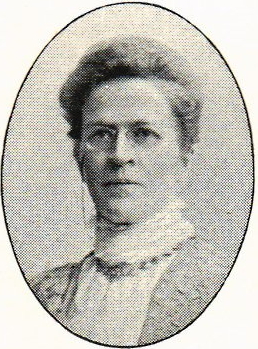Maria Cederschiöld facts for kids
Maria Cederschiöld (born June 29, 1856, died October 19, 1935) was an important Swedish journalist and a strong supporter of women's rights. She made history as the first woman in Sweden to become the chief editor of the foreign news section at a major newspaper, Aftonbladet, from 1909 to 1921. She also played a big role in the Swedish branch of the International Council of Women.
Early Life and Education
Maria Cederschiöld was born in Stockholm. Her father was a government official. After he passed away in 1860, her family faced tougher times and lived with her grandmother.
Maria went to school at the Statens normalskola för flickor from 1864 to 1870 and then the Wallinska flickskolan from 1872 to 1874. In 1874, she took her Studentexamen, which was a big exam needed to go to university. At that time, girls' schools couldn't give this degree. So, Maria and four other girls studied at home and took the exam with boys at a boys' school. One of these girls, Ellen Fries, became her lifelong friend.
Career and Journalism
Maria really wanted to go to university, but her family couldn't afford it. They chose to pay for her brother's studies instead. So, Maria worked as a governess (a private teacher) from 1874 to 1876, a translator from 1876 to 1877, and a teacher at Wallinska flickskolan from 1877 to 1884.
In 1884, Maria started working at Aftonbladet, a well-known newspaper. She got the job partly because of Anna Hierta-Retzius, who was a major owner of the newspaper. Maria translated articles, wrote about international news, and reviewed books.
In 1909, she became the head of the foreign news department. This was a huge step, as she was the first woman in Sweden to hold such a high position in journalism. She was a true pioneer! In 1911, she joined the Swedish Publicists' Association, a group for journalists.
Maria once said that it was actually easier for women to become journalists in the 1880s. She felt that people were more open to women working back then, before competition became too strong. She believed that early women pioneers were often treated with kindness, even by men, because they weren't seen as a threat.
Fighting for Women's Rights
Maria Cederschiöld was very active in the movement for women's rights, both in Sweden and around the world.
From 1884 to 1900, she was the secretary of the Svenska Kvinnors Nationalförbund, which was the Swedish part of the International Council of Women. She later became its vice chairperson from 1909 to 1919. She traveled to many international meetings, including in London (1899), Paris (1900), and Berlin (1904), representing Sweden.
In 1902, she wrote an important appeal that was sent to the Swedish parliament. This appeal, signed by 4,154 people, asked for women's suffrage, meaning the right for women to vote. This happened before the main group for women's voting rights, the National Association for Women's Suffrage, was even created.
Maria was also a member of other women's groups, like Nya Idun. From 1892 to 1895, she was the secretary of the Married Woman's Property Rights Association, which worked to give married women more control over their own money and property. She was involved in many other groups that supported women's rights, welfare, and literature.
Published Works
Maria Cederschiöld also wrote several books and articles:
- Lars Johan Hierta och kvinnas rätt i samhället (Lars Johan Hierta and the rights of women in society) (1901)
- Den svenska gifta kvinnans rättsliga ställning (The legal position of the married Swedish woman) (1903)
- En banbryterska. En minnesskrift över Ellen Fries (A pioneer. A memorial over Ellen Fries) (1913)


